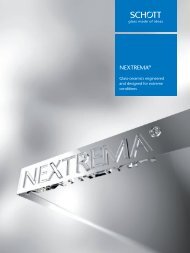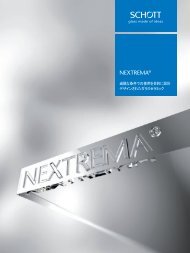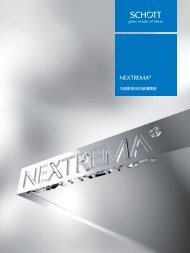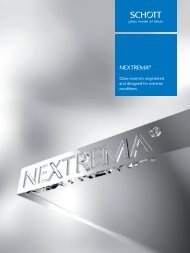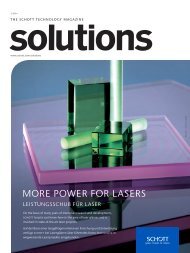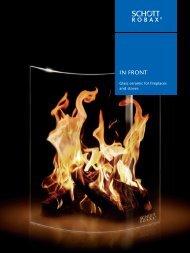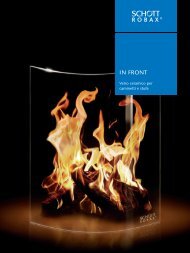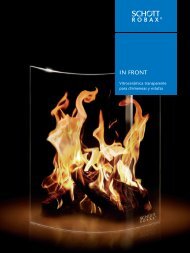SCHOTT Technical Glasses
Apart from its application in optics, glass as a technical material has exerted a formative influence on the development of important technological fields such as chemistry, pharmaceutics, automotive, optics, optoelectronics and information technology. SCHOTT Technical Glasses offers pertinent information in concise form. It contains general information for the determination and evaluation of important glass properties and also informs about specific chemical and physical characteristics and possible applications of the commercial technical glasses produced by SCHOTT. With this brochure, we hope to assist scientists, engineers, and designers in making the appropriate choice and make optimum use of SCHOTT products.
Apart from its application in optics, glass as a technical material has exerted a formative influence on the development of important technological fields such as chemistry, pharmaceutics, automotive, optics, optoelectronics and information technology. SCHOTT Technical Glasses offers pertinent information in concise form. It contains general information for the determination and evaluation of important glass properties and also informs about specific chemical and physical characteristics and possible applications of the commercial technical glasses produced by SCHOTT. With this brochure, we hope to assist scientists, engineers, and designers in making the appropriate choice and make optimum use of SCHOTT products.
You also want an ePaper? Increase the reach of your titles
YUMPU automatically turns print PDFs into web optimized ePapers that Google loves.
27<br />
Internal transmittance ––><br />
0.99<br />
0.98<br />
0.96<br />
0.90<br />
0.70<br />
0.50<br />
0.30<br />
0.10<br />
0.01<br />
1E-04<br />
200 300 400 500 600 700 800 900 1000 1100 1200<br />
Wavelength in nm ––><br />
UG5<br />
UG11<br />
UG1<br />
Fig. 25. UV bandpass filter for a glass thickness of 1 mm<br />
5.4 Color of glass<br />
Color is a sensation perceived by the human eye when<br />
observing an illuminated filter glass or incandescent object.<br />
The color of glass is a function of its spectral transmission<br />
and the spectral energy distribution of the illuminating light<br />
source. Color stimulus is measurable and is defined by three<br />
numerical values (X, Y, Z) in accordance with color metric<br />
conventions set forth by the CIE (see publication CIE N°<br />
15.2 (1986)). The first value is its brightness (standard tristimulus<br />
value) Y and the other two values define the color<br />
locus. There are two possibilities to define the color locus<br />
F (see Figure 26): Either the chromaticity coordinates x and<br />
y, or the dominant wavelength λ d (at S) and the excitation<br />
purity Pe = DF : DS.<br />
5.5 Stress birefringence<br />
Owing to its very structure, glass is an isotropic material.<br />
Mechanical stress causes anisotropy which manifests itself<br />
as stress-induced birefringence. A ray of light impinging<br />
on glass will be resolved into two components vibrating in<br />
planes perpendicular to each other and having different<br />
phase velocities. After passing through a plate of thickness d<br />
which is subjected to a principal stress difference Δσ, an<br />
optical path difference Δs exists between the two compo<br />
nents. This path difference can either be estimated by<br />
means of the birefringence colors or measured with compensators:<br />
Δs = K ∙ d ∙ Δσ [nm].<br />
K is the stress-optical coefficient of the glass (determination<br />
according to DIN 52314).<br />
K = Δs<br />
d<br />
1<br />
Δσ [MPa-1 ]<br />
Many glasses have stress-optical coefficients of about<br />
3 x 10 –6 MPa –1 , and borosilicate glasses of up to 4 x 10 –6 MPa –1 .<br />
High-lead content glasses can have values down to nil or<br />
even negative.<br />
5<br />
Stress-optical measurements permit the determination of<br />
S: Point at which the extension DF intersects the spectrum locus at λ d<br />
permanent stress in glass (state of annealing) as well as of<br />
reactive stress caused as a reaction to exterior forces. Stressoptical<br />
measurements for the evaluation of glass seals with<br />
other glasses, metals, or ceramics are of particular importance.<br />
These offer a sensitive method of deter mining thermal<br />
expansion and contraction differences.<br />
1.0<br />
y 0.9<br />
520<br />
0.8<br />
510 540<br />
0.7<br />
560<br />
0.6<br />
0.5<br />
500<br />
S<br />
F 580<br />
0.4<br />
600<br />
0.3<br />
490<br />
D<br />
620<br />
700<br />
0.2<br />
480<br />
0.1<br />
0<br />
400<br />
0.1 0.2 0.3 0.4 0.5 0.6 0.7 0.8 0.9 1.0<br />
x<br />
Fig. 26. The color of optical filter glasses according to the definition<br />
of CIE 1931<br />
D: Color locus of the radiation source, for example D65






